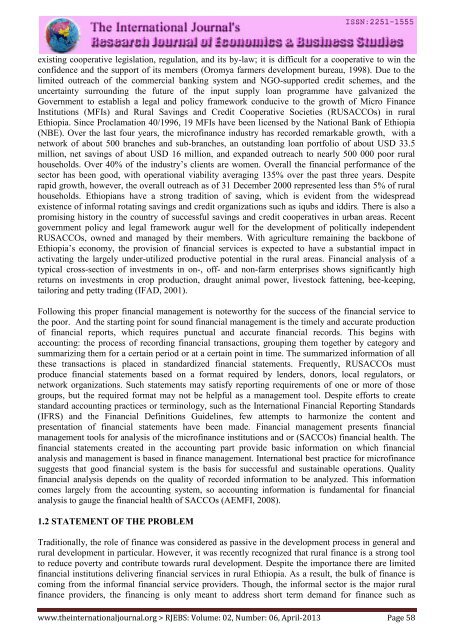Research Journal of Economics & Business Studies - RJEBS - The ...
Research Journal of Economics & Business Studies - RJEBS - The ...
Research Journal of Economics & Business Studies - RJEBS - The ...
- No tags were found...
Create successful ePaper yourself
Turn your PDF publications into a flip-book with our unique Google optimized e-Paper software.
existing cooperative legislation, regulation, and its by-law; it is difficult for a cooperative to win the<br />
confidence and the support <strong>of</strong> its members (Oromya farmers development bureau, 1998). Due to the<br />
limited outreach <strong>of</strong> the commercial banking system and NGO-supported credit schemes, and the<br />
uncertainty surrounding the future <strong>of</strong> the input supply loan programme have galvanized the<br />
Government to establish a legal and policy framework conducive to the growth <strong>of</strong> Micro Finance<br />
Institutions (MFIs) and Rural Savings and Credit Cooperative Societies (RUSACCOs) in rural<br />
Ethiopia. Since Proclamation 40/1996, 19 MFIs have been licensed by the National Bank <strong>of</strong> Ethiopia<br />
(NBE). Over the last four years, the micr<strong>of</strong>inance industry has recorded remarkable growth, with a<br />
network <strong>of</strong> about 500 branches and sub-branches, an outstanding loan portfolio <strong>of</strong> about USD 33.5<br />
million, net savings <strong>of</strong> about USD 16 million, and expanded outreach to nearly 500 000 poor rural<br />
households. Over 40% <strong>of</strong> the industry’s clients are women. Overall the financial performance <strong>of</strong> the<br />
sector has been good, with operational viability averaging 135% over the past three years. Despite<br />
rapid growth, however, the overall outreach as <strong>of</strong> 31 December 2000 represented less than 5% <strong>of</strong> rural<br />
households. Ethiopians have a strong tradition <strong>of</strong> saving, which is evident from the widespread<br />
existence <strong>of</strong> informal rotating savings and credit organizations such as iqubs and iddirs. <strong>The</strong>re is also a<br />
promising history in the country <strong>of</strong> successful savings and credit cooperatives in urban areas. Recent<br />
government policy and legal framework augur well for the development <strong>of</strong> politically independent<br />
RUSACCOs, owned and managed by their members. With agriculture remaining the backbone <strong>of</strong><br />
Ethiopia’s economy, the provision <strong>of</strong> financial services is expected to have a substantial impact in<br />
activating the largely under-utilized productive potential in the rural areas. Financial analysis <strong>of</strong> a<br />
typical cross-section <strong>of</strong> investments in on-, <strong>of</strong>f- and non-farm enterprises shows significantly high<br />
returns on investments in crop production, draught animal power, livestock fattening, bee-keeping,<br />
tailoring and petty trading (IFAD, 2001).<br />
Following this proper financial management is noteworthy for the success <strong>of</strong> the financial service to<br />
the poor. And the starting point for sound financial management is the timely and accurate production<br />
<strong>of</strong> financial reports, which requires punctual and accurate financial records. This begins with<br />
accounting: the process <strong>of</strong> recording financial transactions, grouping them together by category and<br />
summarizing them for a certain period or at a certain point in time. <strong>The</strong> summarized information <strong>of</strong> all<br />
these transactions is placed in standardized financial statements. Frequently, RUSACCOs must<br />
produce financial statements based on a format required by lenders, donors, local regulators, or<br />
network organizations. Such statements may satisfy reporting requirements <strong>of</strong> one or more <strong>of</strong> those<br />
groups, but the required format may not be helpful as a management tool. Despite efforts to create<br />
standard accounting practices or terminology, such as the International Financial Reporting Standards<br />
(IFRS) and the Financial Definitions Guidelines, few attempts to harmonize the content and<br />
presentation <strong>of</strong> financial statements have been made. Financial management presents financial<br />
management tools for analysis <strong>of</strong> the micr<strong>of</strong>inance institutions and or (SACCOs) financial health. <strong>The</strong><br />
financial statements created in the accounting part provide basic information on which financial<br />
analysis and management is based in finance management. International best practice for micr<strong>of</strong>inance<br />
suggests that good financial system is the basis for successful and sustainable operations. Quality<br />
financial analysis depends on the quality <strong>of</strong> recorded information to be analyzed. This information<br />
comes largely from the accounting system, so accounting information is fundamental for financial<br />
analysis to gauge the financial health <strong>of</strong> SACCOs (AEMFI, 2008).<br />
1.2 STATEMENT OF THE PROBLEM<br />
Traditionally, the role <strong>of</strong> finance was considered as passive in the development process in general and<br />
rural development in particular. However, it was recently recognized that rural finance is a strong tool<br />
to reduce poverty and contribute towards rural development. Despite the importance there are limited<br />
financial institutions delivering financial services in rural Ethiopia. As a result, the bulk <strong>of</strong> finance is<br />
coming from the informal financial service providers. Though, the informal sector is the major rural<br />
finance providers, the financing is only meant to address short term demand for finance such as<br />
www.theinternationaljournal.org > <strong>RJEBS</strong>: Volume: 02, Number: 06, April-2013 Page 58

















